Key Concepts
Significant and persistent changes in the state of Earth’s climate. Earth's past climates, or paleoclimates, have alternated between ice ages and periods warmer than today over relatively long time scales (millions to tens of millions of years) because of natural causes, such as the concentration of carbon dioxide in the atmosphere, the positions of the continents, ocean circulation, solar output, and the Earth's orbit. However, since the mid-twentieth century, global climate change has been driven primarily by human-caused greenhouse-gas emissions (Fig. 1) that are trapping additional heat in the atmosphere. See also: Glacial history; Ocean circulation; Paleoclimatology; Paleogeography; Plate tectonics; Precession of equinoxes; Solar constant
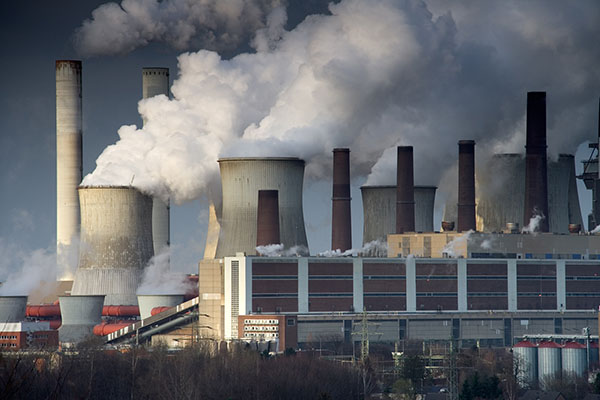
There is a scientific consensus that human factors (forcings) are the primary cause of Earth's changing climate and that global climate change cannot be explained by natural forcings alone (Fig. 2). Scientists have combined a variety of measurements of Earth—from weather-station measurements to sea-ice, glacier, and snow-pack records—to show that the planet’s global average surface temperature has increased since preindustrial times. Studies of proxy measurements from paleoclimatological records, such as tree rings and ice cores, conclude that levels of carbon dioxide (the main greenhouse gas produced by people) are the highest they have been in at least 800,000 years. Studies of all of these lines of evidence show that Earth’s average surface temperature is the highest it has been in at least 1700 years, and that humans have been the primary driver of temperature increases since the mid-twentieth century. In addition to increases in Earth's average surface temperature, increases in greenhouse-gas levels (especially carbon dioxide) and the amount of heat trapped by Earth's atmosphere are causing changes in many components of our climate system, including gradual changes in precipitation, sea level, snow cover, and the timing of the seasons, as well as changes in the magnitude and intensity of extreme weather events such as hurricanes, heat waves, and drought. Climate change is projected to continue throughout the twenty-first century and beyond, with the magnitude and extent of climate change depending on the amount of greenhouse gases emitted to the atmosphere by humans. Climate change is already having significant effects on society and is projected to have large effects on many aspects of life on Earth, including the food security, coastal resilience, health, and livelihoods of people in many regions as the century continues. See also: Carbon dioxide; Climatology; Dendrochronology; Drought; Glaciology; Hurricane; Precipitation (meteorology); Sea ice; Seasons
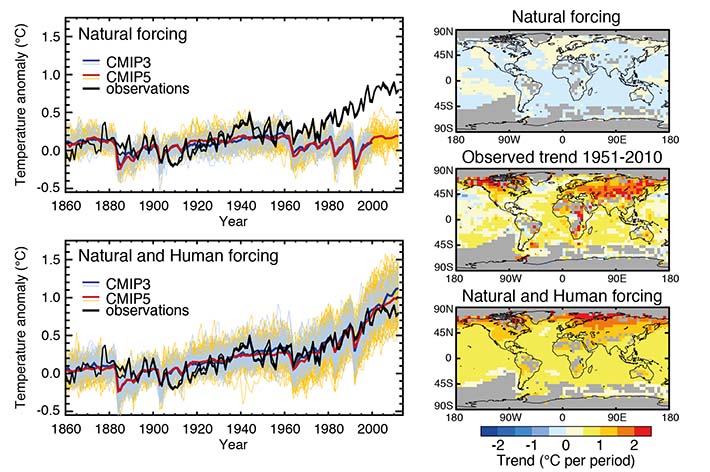
Greenhouse effect
Earth’s atmosphere is unique among the planets of our solar system. Earth’s gravity keeps a blend of gases—predominantly nitrogen and oxygen—close to the planet’s surface, forming the atmosphere. Smaller amounts of other gases, including carbon dioxide and methane, trap heat in a phenomenon known as the greenhouse effect. Over the course of Earth’s history, the greenhouse effect has helped keep temperatures at a relatively stable level that can support life. See also: Atmosphere; Greenhouse effect; Methane
The onset of the Industrial Revolution in the middle of the eighteenth century marked the beginning of large-scale burning of fossil fuels, such as coal and natural gas to power engines, of which several greenhouse gases are a by-product. As a result, there has been a rapid increase in the amount of greenhouse gases, such as carbon dioxide, in the atmosphere since preindustrial times. Between 1750 and 2011, levels of carbon dioxide increased by 40 percent (from 278 to 390.5 parts per million), methane increased by 150 percent (from 772 to 1803 parts per billion), and nitrous oxide increased by 20 percent (from 271 to 324.2 parts per billion). Carbon dioxide levels have increased even further since then, reaching 408 parts per million as of May 2018—the highest in at least 800,000 years (Fig. 3). See also: Coal; Fossil fuel; Natural gas; Nitrogen oxides
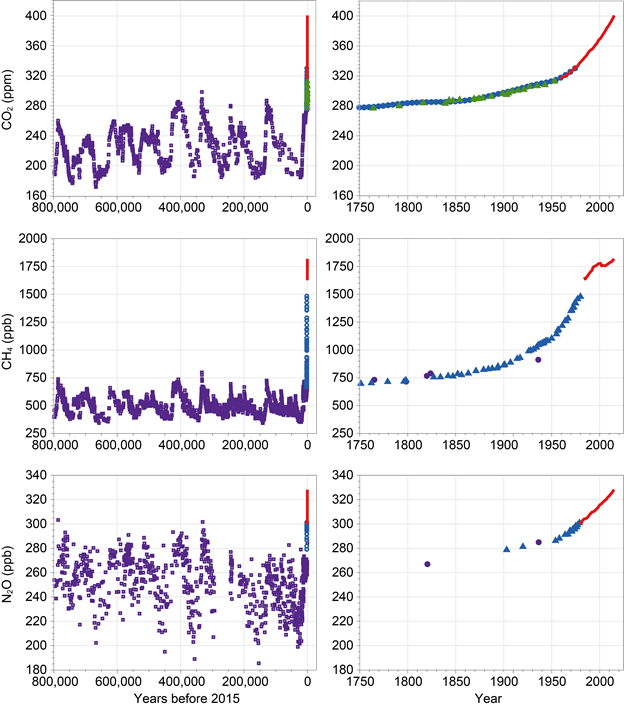
Observed changes in Earth’s climate system
The increased concentration of greenhouse gases in the atmosphere has had a detectable influence on Earth’s climate, with land-use change (largely deforestation) contributing to changes as well. Increases in Earth’s temperature provide an indicator that is useful for assessing the state of the planet, in the same way that people use temperature readings to assess their own health. Scientists have combined multiple lines of evidence (including weather-station and satellite measurements of Earth’s surface temperature, ocean heat-content readings, and ice-sheet, glacier, and snow-pack records) to confirm that Earth’s temperature has increased since preindustrial times. From 1880 to 2012, the average temperature of Earth’s surface (land and oceans combined) has increased by approximately 0.85°C (1.5°F) [Fig. 4]. See also: Deforestation; Satellite meteorology; Weather observations
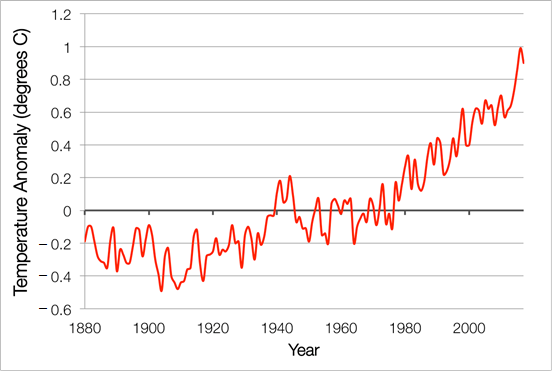
Using state-of-the-art climate models, scientists are able to determine what Earth’s temperature would be without human activity, and compare it with observed temperature records, as well as with the influence of other drivers of the Earth’s climate, including solar and volcanic activity (Fig. 5). Models that are run without human-caused greenhouse gas emissions (that is, are run only with natural drivers of climate such as solar and volcanic activity) do not match observed temperature records. With such evidence, the Intergovernmental Panel on Climate Change (IPCC)—the international scientific body for evaluating climate science—assessed in 2014 that: “Human influence on the climate system is clear, and recent anthropogenic [human-caused] emissions of greenhouse gases are the highest in history;” and “Warming of the climate system is unequivocal, and since the 1950s, many of the observed changes are unprecedented over decades to millennia.”
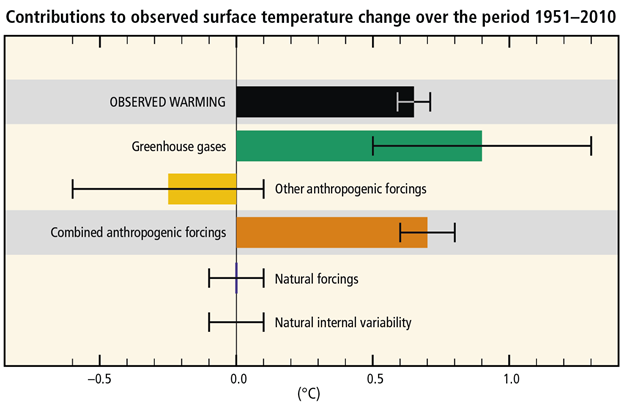
The effect of additional, human-caused greenhouse-gas emissions is detectable in many other parts of Earth’s climate system as well. The ocean has absorbed a clear majority (approximately 93 percent) of the additional heat trapped by human-caused greenhouse gases. The ocean also currently absorbs more than 25 percent of the carbon emitted by human activity, which has increased the acidity of the ocean by 26 percent since preindustrial times. See also: Ocean acidification; Ocean warming
Increases in Earth’s temperature have led to widespread changes in the polar regions. The Greenland and Antarctic ice sheets have lost mass, and the size of glaciers has decreased around the world. In the Arctic Ocean, sea ice started to decline in the 1950s. In Antarctica, while some parts of the region have seen increases in the extent of sea ice and others have seen decreases, the amount of sea ice in the region has increased overall since 1979, likely because of natural climate variations. See also: Antarctica; Arctic Ocean; Greenland
As a result of increases in the ocean’s temperature, the volume of the ocean has increased because warm water expands. Melting glaciers and ice sheets have introduced additional water into the ocean, causing its volume to increase further. Together, these factors have caused Earth’s sea level to rise by 18–20 cm (7–8 in.) since 1900, with much of the increase resulting from human-caused climate change. See also: Sea-level rise
As human-caused greenhouse-gas emissions have accumulated in increasing quantities in Earth’s atmosphere, trends in a variety of extreme weather events have started to emerge. For example, since 1950, there has been an increase in both the number and intensity of days with extreme heat around the world. Changes in extreme weather events are also increasingly detectable at the regional scale. Large portions of Europe, Asia, and Australia are experiencing more frequent heat waves. In the western United States, forest wildfire activity has increased since the 1980s. Hurricane activity has increased in the North Atlantic since the 1970s. Scientists are also increasingly able to attribute the influence of human-caused greenhouse-gas emissions to individual extreme weather events. In 2017, Hurricane Harvey caused widespread loss of life and property after that Category 4 storm made landfall throughout the Caribbean, Yucatán Peninsula, along the Gulf of Mexico, and inland in the United States. Following the storm, researchers found that the record-breaking rainfall that fell over Houston, Texas, was three times more likely and 15 percent more intense because of human-caused climate change. See also: Extreme weather events; Forest fire; Hurricane Harvey (Atlantic, 2017)
Projected changes in Earth’s climate system
Moving forward, the magnitude of future climate change depends on the extent to which people emit additional greenhouse gases into the atmosphere. To understand this, scientists have used computer models to simulate how climate is likely to change for different greenhouse-gas emission trajectories. In the short term (2021–2050), warming is less sensitive to the emissions trajectory that society follows. Earth’s average surface temperature is projected to increase by approximately 1.4°C (2.5°F) relative to recent (1976–2005) conditions. However, toward the end of the century (2081–2100), if greenhouse-gas emissions continue to increase considerably throughout the century (in a scenario known as Representative Concentration Pathway 8.5), Earth’s average surface temperature could increase by between 3.2 and 6.6°C (5.8 and 11.9°F), whereas if greenhouse-gas emissions peak in the next few decades and then decline (in a scenario known as Representative Concentration Pathway 4.5), warming would reach between 1.6 and 4.1°C (2.8 and 7.3°F). Additional emissions reductions (also known as climate-change mitigation) and removal of carbon dioxide from the atmosphere (through, for example, reforestation and direct air carbon capture and storage technologies) would reduce warming levels further. See also: Carbon capture and storage; Climate modeling; Global warming; Reforestation
Beyond increases in the average temperature of Earth, many aspects of the climate system are projected to change across the world—from changes in the ocean to changes in the intensity of extreme heat, to changes in the risk of drought and flooding in many regions. Depending on the amount of greenhouse gases that humans emit and uncertainty in climate models, sea levels are projected to rise by between 0.3 and 1.3 m (1.0 and 4.3 ft) by the end of the twenty-first century, as compared to sea level in the year 2000.
The frequency of hurricanes (known as tropical cyclones in some parts of the world) is not expected to increase globally over the twenty-first century. However, the intensity of those storms that do form is projected to increase, with stronger winds and larger amounts of precipitation. With both higher sea levels and increased hurricane intensity in a warming world, there will be more water available for storms to push onshore. As a result, flood risk is projected to increase for many coastal communities, such as those along the eastern seaboard of the United States.
Heat waves are projected to become more frequent and to last longer, as the planet continues to warm. Extreme heat poses significant health risks, especially for populations that are disproportionately vulnerable or exposed to heat stress, such as the elderly and outdoor workers. In the United States, by the end of the twenty-first century, each year’s hottest days are projected to be 5.5°C (10°F) warmer than recent conditions if greenhouse gas emissions continue to increase significantly (Representative Concentration Pathway 8.5). See also: Deadly heat in an era of global climate change
The colder, high-latitude portions of the planet are likely to experience significant changes throughout the twenty-first century. In both the Arctic and Antarctic, the extent of sea ice is projected to progressively decrease. In the Northern Hemisphere, snow cover is expected to decrease as the planet warms. Reduced snowpack and a shorter snow season are likely to have significant consequences for many aspects of life in these regions, from altered hydrology to increased drought and wildfire risk, to economic effects in places where tourism is dependent on snow cover.
If humans stopped emitting greenhouse gases today, temperatures would continue to increase for a relatively short period of time and approximately stagnate for several centuries before beginning to decline, as it takes decades to thousands of years for different greenhouse gases to cycle out of the atmosphere. Sea levels would still continue to rise over many centuries, as it takes a long time for ocean layers to mix and come to equilibrium. Thermal expansion of the ocean would thus persist for many centuries.
Additional consequences for society
Climate change is projected to alter many aspects of life on Earth. For example, as global average temperatures increase, the risk of adverse effects on food security increases. Crop yields are projected to decrease as temperatures rise in many regions, with low-latitude regions that have higher baseline temperatures at a disproportionate risk. Some northern-latitude regions could see increased crop yields at lower levels of warming. The livestock sector is also vulnerable to increasing temperature, with dairy cows being particularly vulnerable to heat stress, which affects milk production.
Climate change will also continue to affect the ocean and the resources on which society depends. Changing temperatures are projected to alter the distribution of fish populations, with low-latitude, tropical regions at risk of reduced fish catches. Research points to the risk that increasing temperatures and ocean acidification poses for many marine calcifying organisms, such as coral and crabs. See also: Corals and ocean acidification
When assessing the effects that climate change are likely to have for people, scientists consider not only whether a population is more likely to be exposed to a physical hazard, such as a hurricane or a drought; they also consider the underlying vulnerability of the population and the resources they have available to cope with the hazard while it is happening, or adapt their way of life to dampen the possible effects that a hazard might have in the future. Vulnerability can stem from factors such as the financial resources of a community and the level of poverty, and the prevalence of young or elderly populations that might be disproportionately affected. By considering these factors together, the risk level of a community to climate change can be assessed.





